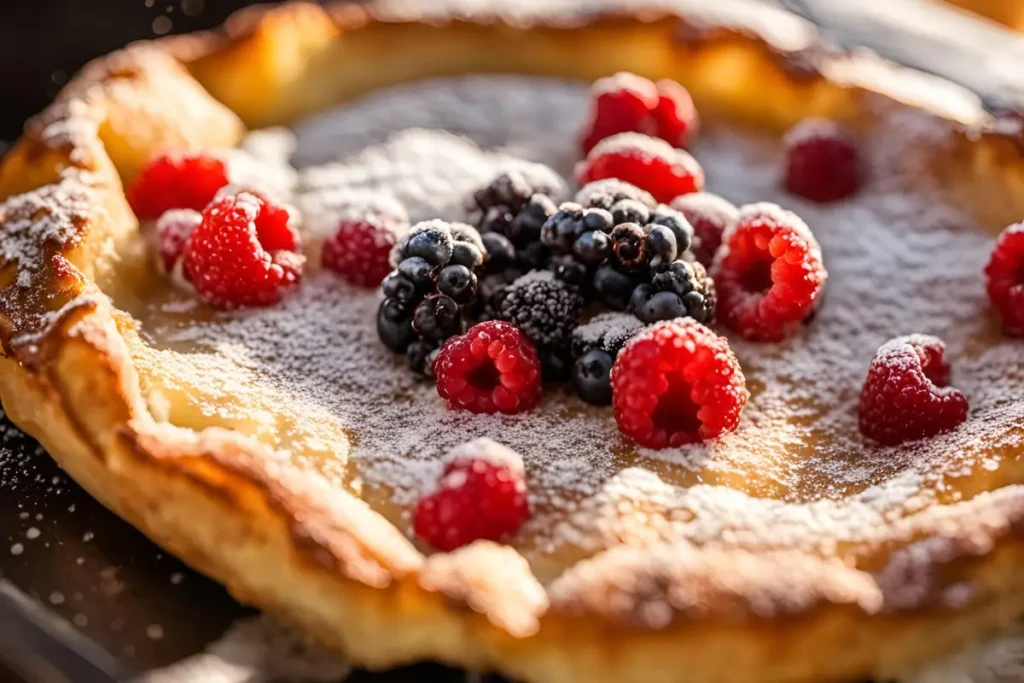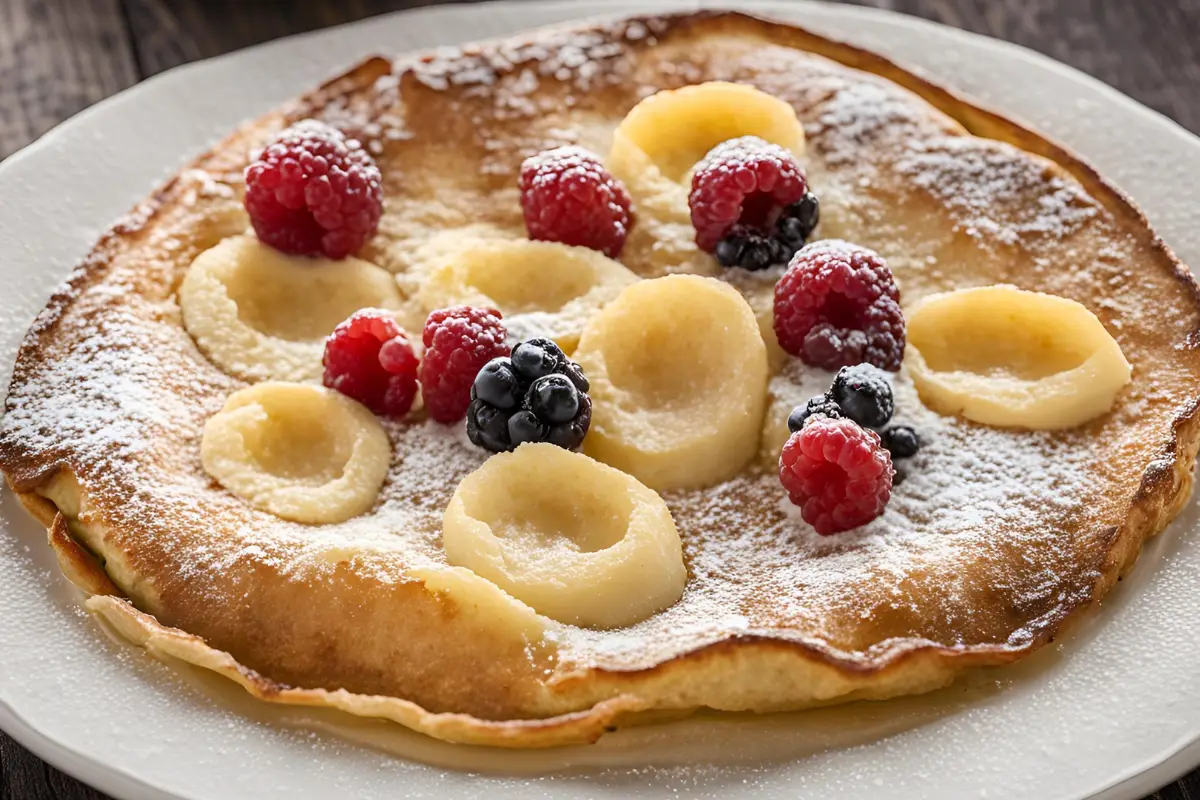When it comes to breakfast, few dishes can compete with the heavenly delight of German Pancakes. Also known as Dutch Babies, these fluffy, puffy wonders are a breeze to whip up and are perfect for any occasion. Whether you’re hosting a weekend brunch or simply treating yourself to a special breakfast, German Pancakes are sure to impress.
What Are German Pancakes?
German Pancakes are not your average flapjacks. Imagine a dish that combines the best elements of a pancake and a popover! These pancakes are baked in the oven, resulting in a light, airy texture that puffs up beautifully. Typically served with a dusting of powdered sugar, a drizzle of syrup, or a sprinkle of fresh fruits, they are as versatile as they are delicious.

Essential Ingredients for German Pancakes
Before diving into the recipe, let’s gather the essentials! Here’s what you’ll need:
| Ingredient | Amount |
|---|---|
| Eggs | 4 large |
| Milk | 1 cup |
| All-purpose flour | 1 cup |
| Salt | 1/4 teaspoon |
| Vanilla extract | 1 teaspoon |
| Butter | 1/2 cup (melted) |
Traditional German Pancakes Recipe
Step-by-Step Instructions
- Preheat the Oven: Preheat your oven to 425°F (220°C). This is crucial for achieving that perfect puff!
- Prepare the Pan: While the oven heats up, melt the butter in a 9×13 inch baking dish. Let it coat the bottom.
- Mix the Batter: In a mixing bowl, whisk together the eggs, milk, flour, salt, and vanilla extract until smooth. Don’t overmix; a few lumps are okay!
- Pour and Bake: Carefully pour the batter into the hot, buttered baking dish. Bake for about 20-25 minutes, or until the edges are golden brown and puffy.
- Serve: Remove from the oven and cut into wedges. Dust with powdered sugar, top with fresh fruit, and drizzle with syrup.
Tips for Achieving the Perfect Puff
To make your German Pancakes rise to new heights, follow these tips:
- Use Room Temperature Ingredients: Cold ingredients can impact the rise. Let your eggs and milk sit at room temperature before mixing.
- Preheat the Pan: Pouring the batter into a hot pan is essential. It helps create that signature puff.
- Don’t Open the Oven: Resist the urge to peek while they bake! Opening the oven can cause them to deflate.
Common Mistakes to Avoid When Making German Pancakes
Even the best cooks can stumble! Here are some common pitfalls to dodge:
- Overmixing the Batter: This can make your pancakes dense. Mix just until combined!
- Not Preheating the Oven: Starting with a hot oven is key to puffiness.
- Using the Wrong Pan: A glass or metal baking dish works best for even cooking.
Best Toppings for German Pancakes
What’s breakfast without some delicious toppings? Here are some favorites:
- Fresh Berries: Strawberries, blueberries, or raspberries add a pop of color and flavor.
- Maple Syrup: A classic choice that never disappoints.
- Powdered Sugar: A light dusting for sweetness.
- Whipped Cream: Because who doesn’t love whipped cream?
- Lemon Juice and Sugar: A delightful combo for a tangy kick.
Creative Variations of German Pancakes
Why stick to the classic when you can experiment? Here are some fun variations:
- Apple Cinnamon: Sauté apples with cinnamon and sugar, then add to your pancake before baking.
- Chocolate Chip: Sprinkle chocolate chips into the batter for a sweet twist.
- Savory German Pancakes: Incorporate cheese and herbs for a unique breakfast treat.
How to Serve German Pancakes for Brunch
Serving Dutch baby Pancakes for brunch? Here’s how to make it special:
- Platter Presentation: Serve on a large platter with a variety of toppings available.
- Garnish: Add fresh mint leaves or edible flowers for an elegant touch.
- Family Style: Let everyone serve themselves, creating a fun and interactive dining experience.
History and Origin of German Pancakes
You might be wondering, where did this delightful dish come from? Dutch baby Pancakes, or Dutch Babies, actually have roots in the U.S. They were popularized in the early 1900s in the Pacific Northwest, influenced by German immigrants. The name “Dutch Baby” is thought to be a playful twist on “Deutsch,” the German word for German.
Making German Pancakes Gluten-Free
Got gluten sensitivities? No problem! You can easily make gluten-free German Pancakes. Substitute the all-purpose flour with a 1:1 gluten-free flour blend. The results are just as fluffy and delicious!
Storing and Reheating Leftover German Pancakes
Have some leftovers? Here’s how to keep them tasty:
- Storing: Place leftover German Pancakes in an airtight container in the fridge for up to 3 days.
- Reheating: Pop them in the toaster or oven at 350°F (175°C) until warmed through.
Creative Recipes Using German Pancakes
Don’t stop at breakfast! Here are some innovative ways to use German Pancakes:
- Breakfast Burritos: Roll up scrambled eggs, cheese, and veggies in a slice of German Pancake.
- Dessert Crepes: Fill with ice cream and drizzle chocolate sauce for a decadent treat.
Beverage Pairings for German Pancakes
What to sip while enjoying your German Pancakes? Here are some ideas:
- Coffee: A classic breakfast drink that complements sweet flavors.
- Fresh Juice: Orange or apple juice brightens up your meal.
- Herbal Tea: For a lighter touch, herbal tea works wonderfully.
Making Mini German Pancakes
Want to create bite-sized goodness? Here’s how to make mini German Pancakes:
- Use a Muffin Tin: Grease a muffin tin and pour in the batter to fill each cup halfway.
- Adjust Baking Time: Bake for 10-15 minutes or until puffed and golden.
Savory German Pancakes
Feeling adventurous? Try these savory Dutch baby Pancakes:
- Spinach and Feta: Add sautéed spinach and crumbled feta for a deliciously different breakfast.
- Mushroom and Cheese: Incorporate sautéed mushrooms and your favorite cheese for a hearty meal.
Side Dishes to Serve with Dutch Baby Pancakes
Round out your breakfast with these delicious sides:
| Side Dish | Description |
|---|---|
| Crispy Bacon | A classic pairing that adds crunch. |
| Breakfast Sausages | Flavorful sausages complement the dish. |
| Fresh Fruit Salad | A refreshing and healthy option. |
Cultural Significance of German Pancakes
Dutch baby Pancakes not only tantalize taste buds but also have cultural significance. They symbolize comfort and family gatherings in many households. Perfect for brunch with friends or cozy mornings at home, these pancakes bring people together.
FAQs About German Pancakes
What’s the difference between German pancakes and regular pancakes?
The primary difference lies in their cooking method and texture. Dutch baby Pancakes, also known as Dutch Babies, are baked in the oven, resulting in a light, airy texture that puffs up dramatically. In contrast, regular pancakes are cooked on a stovetop and typically have a denser, flatter consistency. The baking process creates a unique outer crispiness while keeping the inside soft and custardy, which sets them apart from their pan-fried counterparts.
What is a German pancake made of?
A traditional German Pancake is made from a simple batter of eggs, milk, all-purpose flour, salt, and vanilla extract. The key ingredient is the eggs, which provide the structure and help the pancake rise during baking. Melted butter is usually added to the baking dish before pouring in the batter, contributing to its rich flavor and texture.
Why do they call them German pancakes?
The dish is actually believed to have been popularized in the United States by German immigrants, but it is not widely known in Germany itself. The term “Dutch Baby” is thought to stem from a mispronunciation of “Deutsch,” the German word for “German.” Thus, while the name suggests a German origin, the dish is more of an American creation influenced by German cooking .
What do Dutch baby pancakes taste like?
Dutch Baby Pancakes have a delightful flavor that is somewhat similar to a custard or a soufflé. The combination of eggs and milk gives it a rich, creamy taste, while the edges become crispy from baking. When topped with ingredients like powdered sugar, syrup, or fresh fruits, the flavors become even more pronounced, balancing sweetness with the pancake’s eggy richness .
Can I use almond milk for German Pancakes?
Absolutely! Almond milk works perfectly as a substitute for regular milk in Dutch baby Pancakes. The flavors blend well, and you won’t lose that fluffy texture.
How can I make German Pancakes dairy-free?
Swap the milk with a non-dairy alternative like oat milk or almond milk, and use a dairy-free butter. This way, you can enjoy delicious German Pancakes without the dairy!
What’s the best way to keep them warm before serving?
To keep your German Pancakes warm, place them in a warm oven set to low heat (around 200°F) until you’re ready to serve. This keeps them nice and fluffy without overcooking them.
Conclusion
There you have it—the ultimate guide to German Pancakes! Whether you stick with the traditional recipe or venture into creative variations, these pancakes are sure to elevate your breakfast game. So gather your ingredients, preheat that oven, and get ready to impress your family and friends with a delicious stack of Dutch baby Pancakes!
If you’re a fan of German pancakes, why not explore more delicious breakfast options? One delightful choice is Pumpkin Pancakes, perfect for adding a seasonal twist to your morning routine. These fluffy pancakes incorporate the warm spices of pumpkin pie and are a hit during the fall, but delicious any time of year! Check out the full recipe here.
For a healthier alternative, try Oatmeal Pancakes. Made with wholesome oats, these pancakes offer a hearty, nutritious start to your day. They’re easy to whip up and can be customized with your favorite toppings, like fresh fruits or a drizzle of honey. You can find the oatmeal pancake recipe here. Both options will add variety to your breakfast table and keep your mornings exciting!
